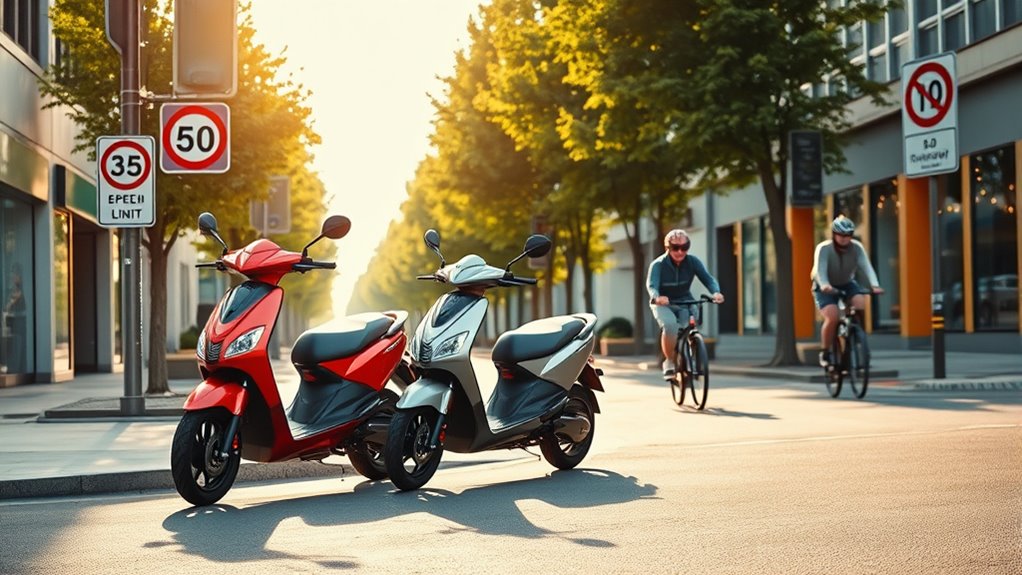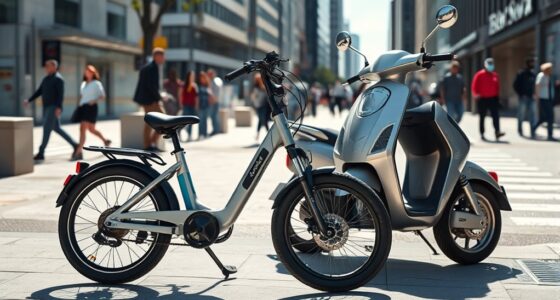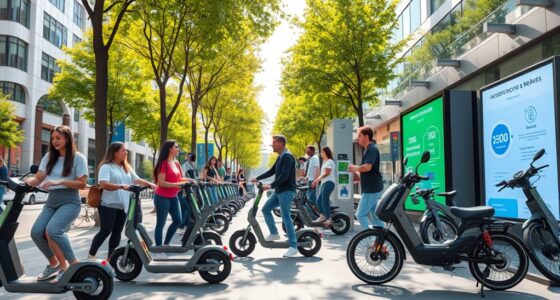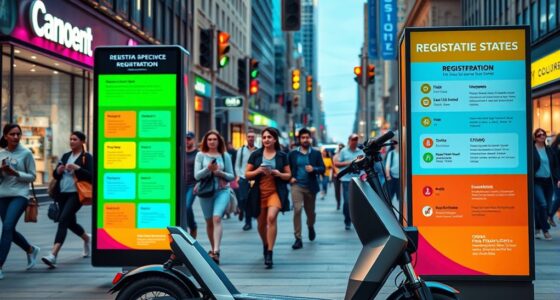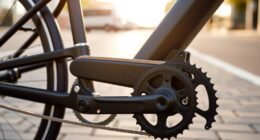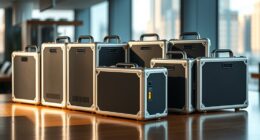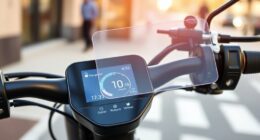To understand speed limits for e‑bikes and scooters, check your local laws since they vary by region and city. Most models conform to class standards: Class 1 and 2 are limited to 20 mph, while Class 3 can reach up to 28 mph. Always follow regional regulations, ride responsibly, and use safety gear at higher speeds. To stay compliant and safe, learn about your area’s specific rules and how to monitor your vehicle’s speed limits.
Key Takeaways
- Speed limits for e-bikes and scooters depend on local laws, regional regulations, and specific vehicle classes.
- Common speed caps are 15-20 mph in bike lanes, up to 25 mph on shared roads, and 10-15 mph in residential areas.
- E-bike classes (1, 2, 3) have maximum speeds of 20 mph or 28 mph, influencing legal compliance and safety.
- Adhering to regional speed regulations ensures legal riding, safety, and avoids penalties or fines.
- Responsible riding at appropriate speeds reduces accident risks and enhances rider safety in different environments.
Regulations by Region and Country

Regulations regarding speed limits for e‑bikes and scooters vary widely depending on your region or country. In many places, local laws specify maximum speeds based on regional licensing requirements, which determine how you can operate different types of e‑vehicles. Some regions enforce strict adherence to manufacturer standards, ensuring that e‑bikes and scooters meet safety and performance criteria before approval. You might find that certain areas limit speeds to 15 mph or less for shared pathways, while others allow up to 28 mph for specific classes of e‑bikes. Always check your local regulations to understand the legal speed limits and licensing requirements. Staying informed helps you ride safely, legally, and within the boundaries set by regional authorities and manufacturer standards. Additionally, understanding the safety implications and compatibility with local transportation regulations, such as zodiac compatibility, can enhance your riding experience and compliance.
Types of E-Bikes and Scooters and Their Speed Capabilities

E‑bikes and scooters come in various types, each designed for different riding styles and speed capabilities. The type of battery technology used influences how fast they can go and how far they can travel. Lithium-ion batteries are common, offering high energy density and quick charging. Motor types also vary, including hub motors and mid-drive motors, which affect speed and performance. Hub motors often provide simpler, more affordable options with moderate speeds, while mid-drive motors deliver higher torque and faster acceleration. Some e-bikes and scooters are built specifically for commuting, with top speeds around 20-30 mph, while others are designed for recreational use, capable of reaching higher speeds. Your choice depends on your needs, riding environment, and the technology powering your vehicle. Additionally, advancements in Quantum computing are expected to influence future developments in vehicle automation and safety features.
Speed Limits for Class 1, 2, and 3 E-Bikes
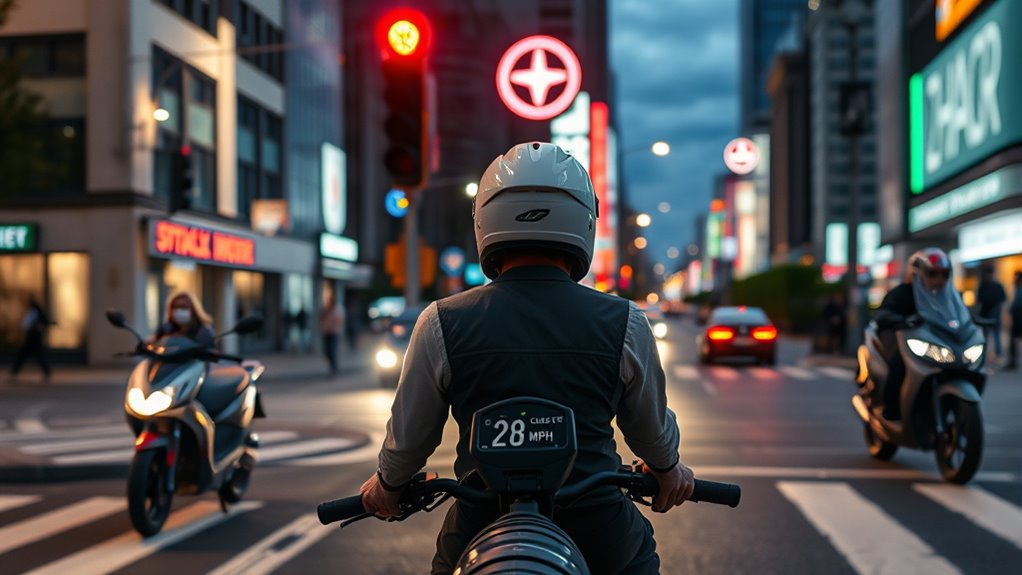
Understanding the speed limits for Class 1, 2, and 3 e-bikes is essential for safe and legal riding. Class 1 e-bikes are limited to 20 mph and typically feature lower motor power, suitable for casual riding. Class 2 e-bikes also reach 20 mph but often have a more powerful motor, which may impact battery capacity and overall range. Class 3 e-bikes can go up to 28 mph, requiring more robust motor power and larger batteries to support higher speeds. Your battery capacity determines how long you can ride at these speeds, while motor power influences acceleration and top speed. Staying within these speed limits ensures you ride safely and avoid legal issues, especially as different classes are regulated differently based on their power and speed capabilities. Existential themes in the design of e-bikes highlight the importance of safe riding practices aligned with legal standards.
Local Laws and Municipal Rules
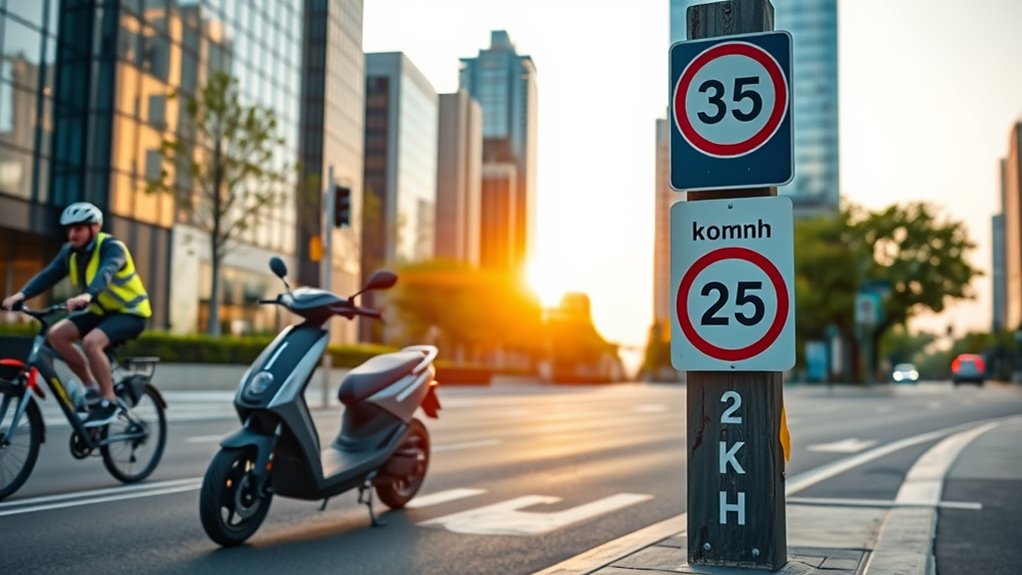
Local laws and municipal rules can vary widely, so it is crucial to know the specific regulations in your area. You might encounter different speed limits, enforcement policies, or restrictions based on your region. Staying informed helps you ride safely and avoid fines or penalties. Additionally, understanding home furnishings safety features can enhance your overall comfort and security while using electric-powered devices.
Local Speed Regulations
Municipalities often establish specific speed limits for e‑bikes and scooters to guarantee safety and harmony on shared roads and pathways. These local regulations vary widely, so you need to stay informed to avoid penalties. Speed limits are often tailored for different environments, such as bike lanes or mixed traffic areas. Proper rider attire, like helmets, combined with adhering to local speed rules, helps prevent accidents. Here’s a quick overview:
| Area Type | Typical Speed Limit | Note |
|---|---|---|
| Bike lane | 15-20 mph | Check local signage for exact limits |
| Shared road | 25 mph or less | Be cautious of pedestrians |
| Residential | 10-15 mph | Focus on safety and visibility |
| Commercial zone | 20 mph | Follow posted signs |
Always respect local rules to ensure safety and avoid fines. Additionally, understanding the speed regulations for different zones helps promote safer riding practices.
Municipal Enforcement Policies
Enforcing speed limits for e‑bikes and scooters involves a combination of laws, patrol oversight, and fines designed to guarantee rider safety and compliance. Municipal enforcement policies rely on clear regulations rooted in urban planning that prioritize safe, accessible routes. Local authorities may implement specific rules to manage how riders use electric infrastructure, ensuring scooters and e‑bikes stay within designated areas. Law enforcement agencies monitor adherence through patrols or technology like cameras and GPS tracking. Penalties for violations act as deterrents, encouraging responsible riding. These policies aim to harmonize rider behavior with city planning efforts, making streets safer for pedestrians and cyclists alike. Effective enforcement guarantees that speed regulations support broader initiatives for sustainable urban mobility. Additionally, the integration of expert voice actors in public service announcements can improve community awareness and compliance.
Varying Regional Limits
Because regional differences substantially impact speed limits for e‑bikes and scooters, understanding local laws and municipal rules is essential for safe riding. Urban infrastructure varies widely, influencing where and how fast you can go. Some cities prioritize efficient mobility, allowing higher speeds on dedicated bike lanes, while others impose strict limits to protect pedestrians and reduce environmental impact. Local regulations often reflect community priorities, affecting your riding experience and safety. Ignoring these limits can lead to fines or accidents. To stay compliant and responsible, research the specific rules in your area. Being aware of regional variations helps you adapt your speed appropriately, supporting safer rides and contributing to a sustainable, eco-friendly transportation ecosystem. Additionally, infrastructure design plays a crucial role in determining safe speed levels and ride quality.
Safety Considerations Based on Speed
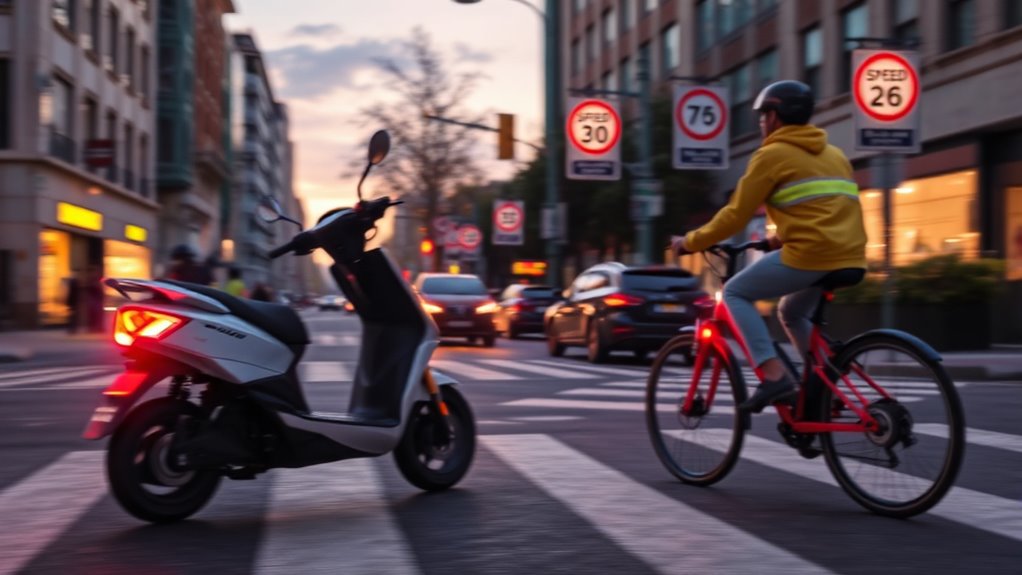
Your speed directly affects how quickly you can react to obstacles or hazards. Wearing the right protective gear becomes even more important as your speed increases. Higher speeds also raise your risk of accidents, making safety precautions essential for a secure ride. Proper safety measures are crucial to minimize injuries and ensure a safe riding experience.
Impact on Reaction Time
Higher speeds on e-bikes and scooters considerably reduce your reaction time, making it harder to respond quickly to obstacles or sudden changes in traffic conditions. When you’re moving faster, even a moment’s delay can lead to accidents. Driver distraction becomes more dangerous at higher speeds, as your ability to notice hazards diminishes. Weather effects, like rain or fog, further impair your reaction, increasing stopping distances and reducing visibility. Consider the emotional impact of these risks:
| Speed | Reaction Time | Consequences |
|---|---|---|
| Fast | Shortened | Increased collision risk |
| Moderate | Balanced | Better hazard response |
| Slow | Extended | More time to react and stop |
Reducing speed enhances your safety by giving you more time to react to unexpected hazards. Additionally, understanding reaction time can help you make safer choices while riding.
Appropriate Protective Gear
As your speed increases on an e-bike or scooter, wearing the right protective gear becomes even more essential to minimize injury risks. High speeds demand better rider safety measures to protect you in case of falls or collisions. Proper protective gear includes more than just a helmet; it’s about thorough safety.
- Wear a well-fitted helmet to protect your head
- Use elbow and knee pads for joint protection
- Consider gloves to improve grip and protect your hands
- Wear reflective clothing or gear for visibility
- Be aware of cookie categories and how they can impact your online safety and experience.
Choosing the right protective gear ensures you’re prepared for higher speeds and helps reduce the severity of injuries. Prioritizing rider safety not only boosts confidence but also makes riding a safer and more enjoyable experience.
Risk of Accidents
Increasing your speed on an e-bike or scooter considerably raises the risk of accidents. Higher speeds reduce your reaction time, making it harder to avoid obstacles or respond to sudden hazards. Helmet safety becomes even more critical, as the severity of injuries increases with speed. Proper rider training helps you control your vehicle effectively and navigate safely at higher speeds. Without adequate training, you might underestimate your limits or mishandle turns and braking. Staying within recommended speed limits minimizes danger and allows you to react promptly to unpredictable situations. Remember, faster doesn’t always mean better—prioritizing safety, wearing a helmet, and getting proper rider training are essential to reduce your risk of accidents and injuries. Effective strategies like proper training can also help you build confidence and improve your overall riding skills.
How to Check Your Vehicle’s Speed Limit Settings
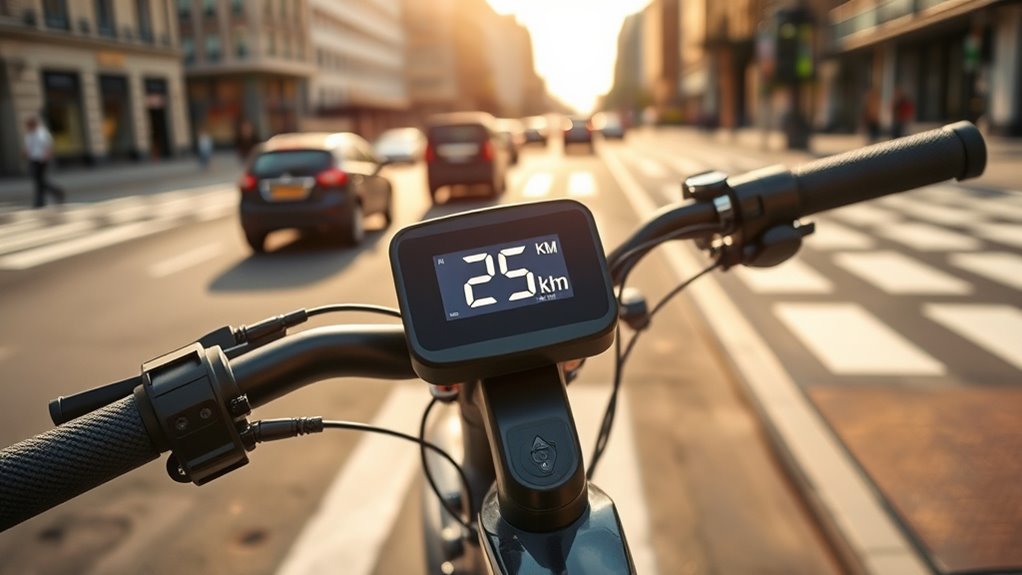
Wondering how to make sure your e‑bike or scooter is set within legal speed limits? First, check your device’s display or app for speed settings. Many models allow you to view and adjust speed limits directly. Also, guarantee your battery maintenance is ideal, as a weak battery can affect speed performance. Next, review your riding posture; leaning forward or slouching can influence your control and speed. To verify your settings:
Check your device settings, maintain your battery, and ride with proper posture to stay within legal speed limits safely.
- Consult your user manual for specific instructions
- Use a GPS speed app for real-time measurement
- Reset or update your device’s firmware if needed
- Test ride in a safe area to confirm the speed limit is within legal range
- Remember that fathers often serve as role models for responsibility and safety, which can influence your riding habits.
Regularly checking these aspects helps keep your rides safe and compliant.
Penalties for Violating Speed Restrictions

Violating speed restrictions on e-bikes and scooters can lead to significant penalties, including fines and suspension of your riding privileges. If you’re caught speeding, you may face hefty speeding fines that vary by region and severity of the violation. Beyond fines, legal penalties can include points on your license or even a temporary or permanent ban from riding. These consequences are designed to enforce safe riding and protect public safety. Ignoring speed limits not only risks legal trouble but also endangers pedestrians and other road users. Security systems can also help monitor and enforce safe riding behaviors in some cases. It’s important to adhere to posted speed restrictions to avoid these penalties. Staying within the legal limits helps you avoid costly fines and keeps you riding responsibly and safely.
Tips for Safe and Responsible Riding
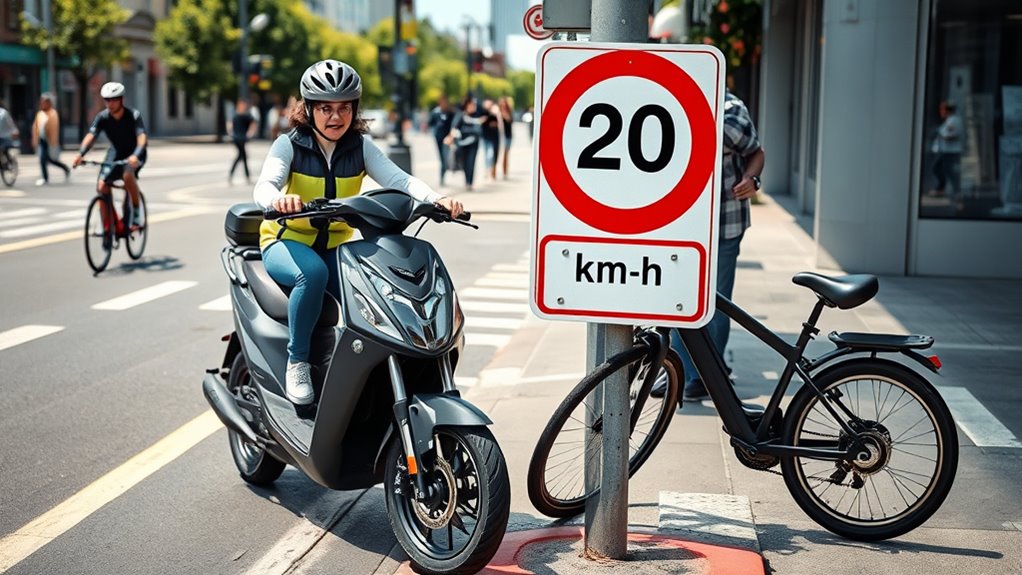
To guarantee your safety and that of others, practicing responsible riding habits is essential. Always wear your helmet safety gear to protect your head in case of a fall or collision. Follow riding etiquette by yielding to pedestrians and signaling your intentions clearly. Keep your speed within the legal limits, especially in crowded areas. Be mindful of your surroundings, watch for obstacles, and avoid sudden stops or sharp turns. Respect traffic laws and local regulations to ensure a smooth ride for everyone. Remember, responsible riding isn’t just about obeying rules; it’s about creating a safer environment for yourself and those around you. By staying alert, courteous, and cautious, you’ll enjoy your e‑bike or scooter while minimizing risks. Using appropriate safety gear and understanding speed limits for e-bikes and scooters can significantly reduce accident risks and enhance your riding experience.
Frequently Asked Questions
How Do I Adjust or Modify My E‑Bike or Scooter’S Speed Limit?
To adjust your e-bike or scooter’s speed limit, start by exploring the device’s settings or app, as many models allow speed limiter adjustments. You can often find speed modification techniques through firmware updates or by installing custom software. Be cautious, though—modifying your speed limiter might void warranties or violate local laws. Always check your device’s manual and local regulations before making any speed adjustments.
Are There Age Restrictions Related to Speed Limits for Riders?
Age restrictions often influence rider qualifications and can determine the maximum speed you’re allowed to ride. Many regions set minimum age limits to ensure safety, especially for high-speed e-bikes and scooters. Check local laws to see if there are specific age restrictions related to speed limits. If you’re underage, you might be restricted to lower speeds or require supervision. Always follow these regulations to stay safe and compliant.
How Do Weather Conditions Affect Safe Riding Speeds?
Weather hazards are like tricky currents in a river that can toss you off course. When riding your e-bike or scooter, you need to make speed adjustments based on rain, fog, or strong winds. These conditions reduce traction and visibility, so slowing down keeps you safe. Always stay alert, adapt your speed, and give yourself extra time to react—your safety depends on it in unpredictable weather.
Can I Legally Ride Faster on Private Property?
On private property, you can often ride faster since local speed limits usually don’t apply. However, you should check if any rules or restrictions exist for that property. Keep in mind, speed modification isn’t always legal if it increases the risk of accidents or violates safety regulations. Always prioritize safety and respect property owner rules to avoid potential legal issues.
What Are the Best Practices for Maintaining Safe Speeds on Busy Streets?
Think of busy streets as a dance floor—you need to move with the rhythm, not against it. You should always adjust your speed to match traffic flow, stay alert, and avoid rushing. Good rider behavior includes slowing down near pedestrians and intersections. Wearing safety gear like a helmet and reflective clothing is essential for protection. By staying mindful and respectful of others, you keep yourself and everyone else safe.
Conclusion
Understanding speed limits helps you ride confidently and safely, like steering a busy street with clear traffic signals. Ignoring these limits risks fines or accidents, much like running a red light. By respecting regulations and checking your e-bike or scooter’s settings, you create a smooth journey—where freedom meets responsibility. Stay informed, ride responsibly, and enjoy the thrill of your ride without compromising safety or legality.
